From the dawn of marine steam propulsion, all ships had been powered by coal, and used their steam in piston engines with increasing numbers of cylinders. The beginning of the 20th century saw coal give way to oil, and the steam turbine replace the reciprocating engine.
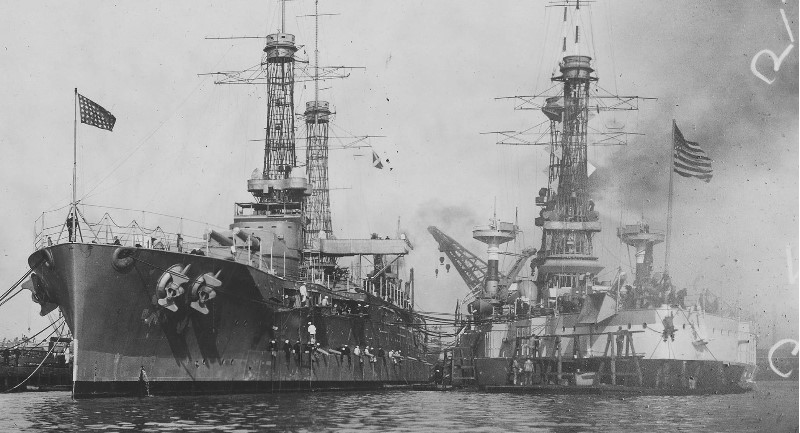
Nevada (left) and Florida, old and new propulsion
The first battleship to burn oil was the Russian Rotislav, for purely economic reasons. Oil was readily available from Baku in the Black Sea, while coal had to be imported, so half of her boilers burned coal, while the other half burned oil. This was not a success, and the Russians soon returned to the use of coal. In the early days, coal firing had been developed to a great degree of sophistication, while the heavy fuel oil used then was extremely difficult to burn efficiently. The British introduced oil on the King Edward VII class, spraying it into coal-fired boilers in an attempt to improve acceleration and reduce the load on the stokers at high speed. This mixed firing was common on battleships worldwide until coal was totally replaced by oil in the 1920s.
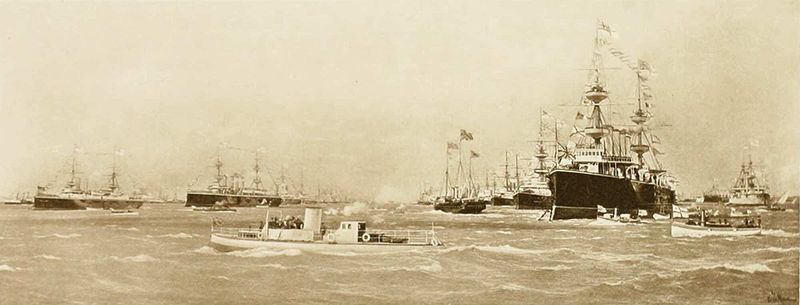
Turbina at the 1897 Spithead Review
The steam turbine was first developed by Charles Parsons, who demonstrated his new invention by steaming through the Queen Victoria's 1897 Diamond Jubilee Naval Review in his yacht Turbinia.1 The yacht, capable of 34.5 kts, was easily the fastest ship of the day. The Admiralty took notice, and soon introduced the turbine into destroyers, where it proved successful. They were rapidly adopted worldwide. In 1907, about 400,000 horsepower worth of turbines were installed in ships.2 A dozen years later, that had risen to 35,000,000.
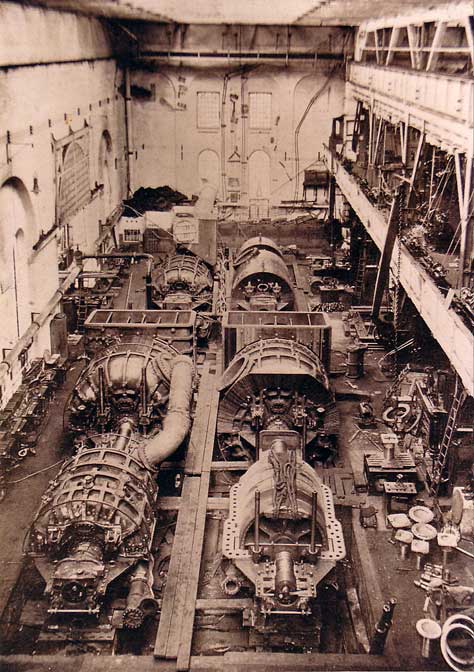
Turbines of HMS Bellerophon, similar to those of Dreadnought
Turbines were famously introduced aboard battleships on Dreadnought.3 They were lighter and smaller than reciprocating engines for a given amount of power,4 and significantly more reliable for sustained high-speed steaming, as their motion did not put nearly as much stress on their components. The biggest drawback was that turbines were significantly less efficient than the triple-expansion engines they replaced. This was because early turbines were directly coupled to the shafts, and while turbines are most efficient at high speed, propellers are most efficient while turning slowly. Dreadnought's engines turned at 325 rpm, as opposed to 120 rpm for the proceeding Lord Nelson class. Another drawback was that turbines were not easily reversed, a problem solved by fitting 'reversing stages', essentially a smaller set of turbines to turn the shafts the other way.
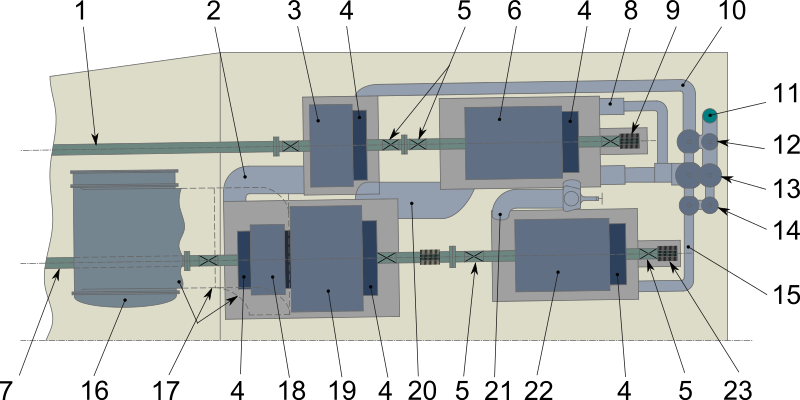
Dreadnought's port engine room. 1 — outlet shaft; 2 — exhaust trunk from high pressure (HP) for low pressure (LP) astern turbine; 3 - HP astern turbine; 4 — dummy piston; 5 — rotor shaft bearings; 6 — HP ahead turbine; 7 — inner shaft; 8 — main steam to HP ahead turbine; 9 — thrust block; 10 — main steam to HP ahead turbine; 11 — main steam from boiler room; 12 — astern manoueuvring valve; 13 — ahead manoueuvring valve; 14 — cruising manoueuvring valve; 15 — main steam to cruising turbine; 16 — main condenser; 17 — exhaust to condenser; 18 — LP astern turbine; 19 — LP ahead turbine; 20 — exhaust trunk from HP for LP ahead turbine; 21 — exhaust trunk from cruising to HP ahead turbine; 22 — cruising turbine.5
Much like reciprocating engines, turbines were most efficient if the steam was expanded multiple times. Dreadnought had four shafts and two engine rooms, with the high pressure turbines on the outer shaft, and the low-pressure turbines on the inner shafts. There were also cruising turbines fitted to the inner shaft. This was to reduce fuel consumption at low speeds, when the turbines would otherwise be turning at an inefficient speed. To be quite honest, I'm not really sure how it worked, and on Dreadnought at least, they were not successful, and were soon disconnected.
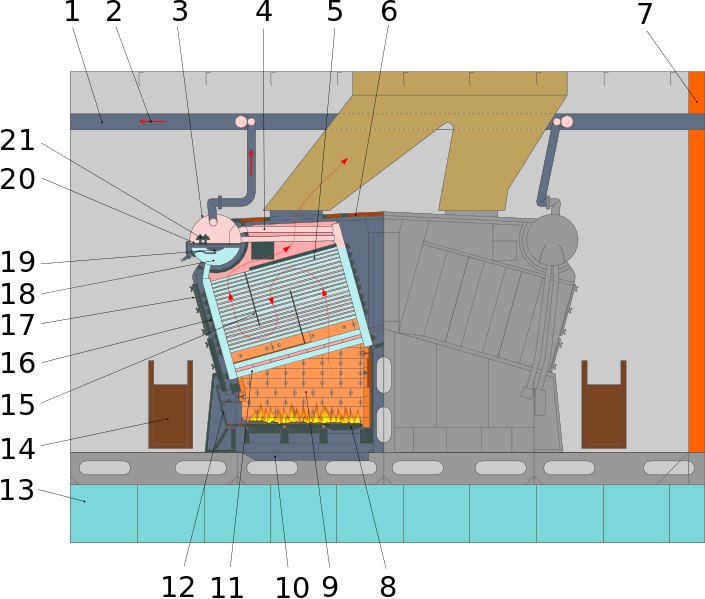
Cross-section of one of Dreadnought's boilers. 1 — main steam pipe; 2 — main steam to engine room; 3 — main steam/water drum; 4 — return tubes; 5 — generating tubes (small); 6 - insulation; 7 — ash hoist; 8 — grate; 9 — fire brics; 10 — ash pen; 11 — generating tubes (large); 12 — furnace door; 13 — reserve feed-water; 14 — coal chute; 15 — cast iron flame plates; 16 — downtake headers; 17 — access door to downtake headers; 18 — water; 19 — upturned pan at the water level connected to scum valve; 20 — wash plate to limit movement of water in drum when ship was rolling; 21 — feed water inlet nozzle.6
Dreadnought's machinery produced 24,712 hp on trials, for a speed of 21.05 kts, making her the fastest battleship in the world at the time. The 18 Babcock & Wilcox boilers in three boiler rooms produced steam at 250 psi and 400 F, with a total coal supply of 2,868 tons, along with 1,120 tons of oil. At the maximum continuous full power speed of 18.9 kts, Dreadnought could make 4,910 nm. At a more economical 12.9 kts, this rose to 7,110 nm.7 Overall, the turbine proved very successful, reducing vibration and allowing ships to sustain much higher speeds.
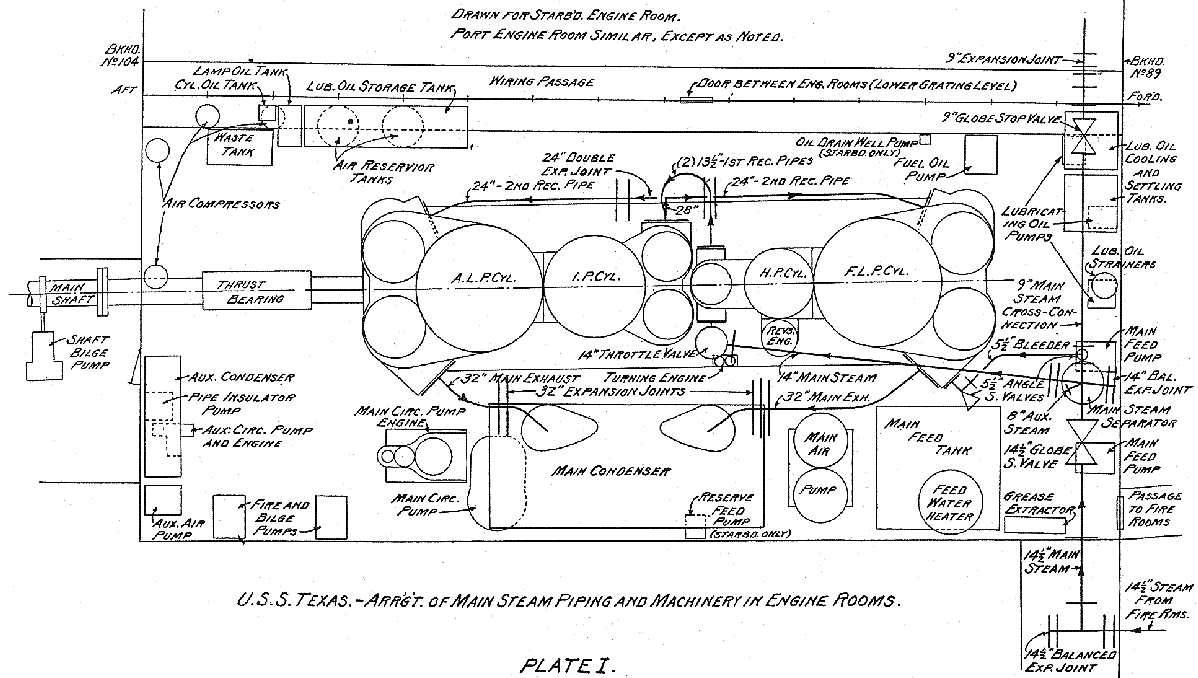
Starboard (reciprocating) engine room of USS Texas
Many navies stuck with the reciprocating engine for their first batch or two of dreadnoughts, unwilling to risk failure on such expensive and important ships. The USN was unique, however, in returning to triple-expansion engines after fitting turbines. This was because the main threat the United States planned against, a Japanese invasion of the Philippines, required great endurance to cross the Pacific. While planning the New York class, the US decided that recent improvements in reliability due to forced lubrication and the increase in range at 12 kts from 5,606 nm to 7,060 nm made reciprocating engines worth it. The following Nevada class saw Nevada equipped with turbines, while her sister Oklahoma got triple-expansion engines. Whatever the logic at the time, the triple-expansion engines were not popular after WWI, and by the time of Pearl Harbor, Oklahoma was limited to 19 kts, as opposed to the 21 kts of the rest of the American battle line.
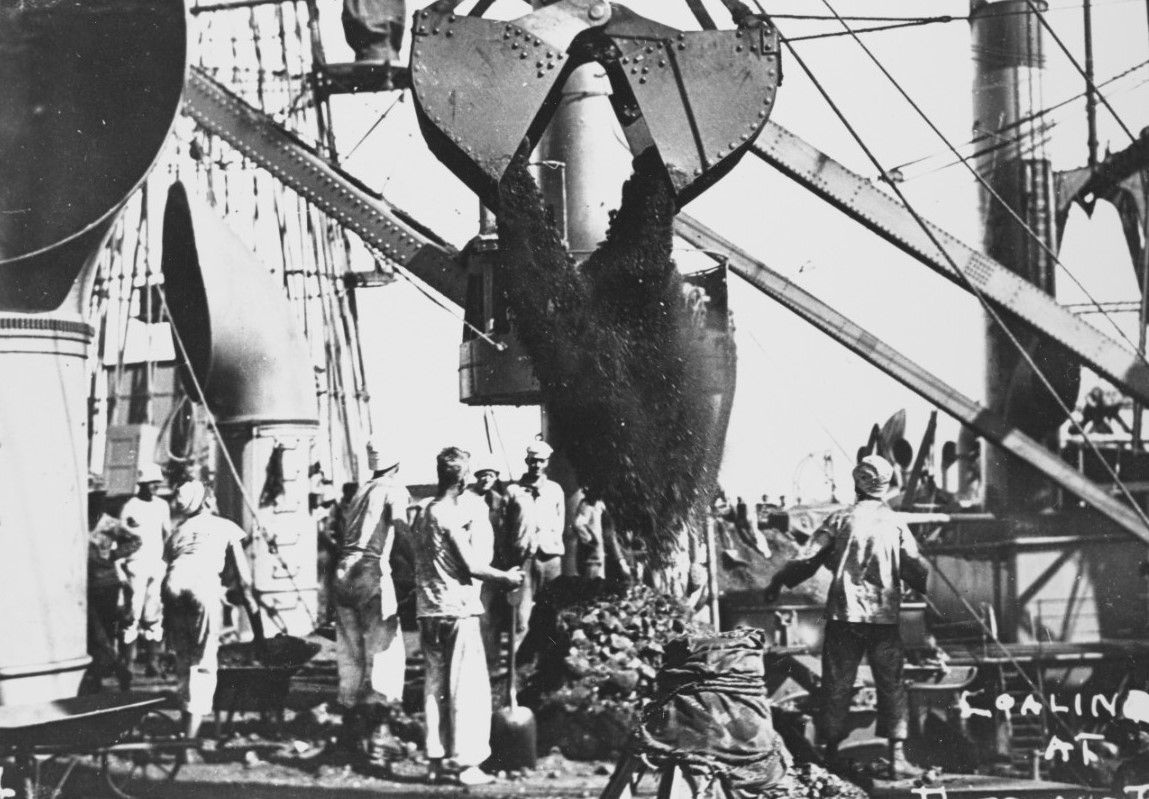
Coaling a battleship
Despite the retrograde nature of her engines, Oklahoma saw another innovation, shared with Nevada. They were the first battleships designed to burn oil alone.8 Oil had many advantages over coal, once efficient oil burners had been invented. Coal, being solid, is difficult to handle. Coaling a ship was a backbreaking exercise that required all hands, and tended to leave a film of coal dust over everything, which is bad for delicate things like optics unless they were covered. Coal also required large crews of stokers, and space around the boiler for coal to be passed into the fires, which in turn limited the size of the boilers. Coal-fired ships could not sustain their maximum speeds very long. Stokers got tired and the nearby bunkers ran out of fuel, forcing the crews to go to less convenient sources of supply. The US estimated that a crew of 100 firemen and 112 coal passers might be replaced by 24 men if oil was adopted. All of this meant that an oil-fired ship could be considerably smaller.
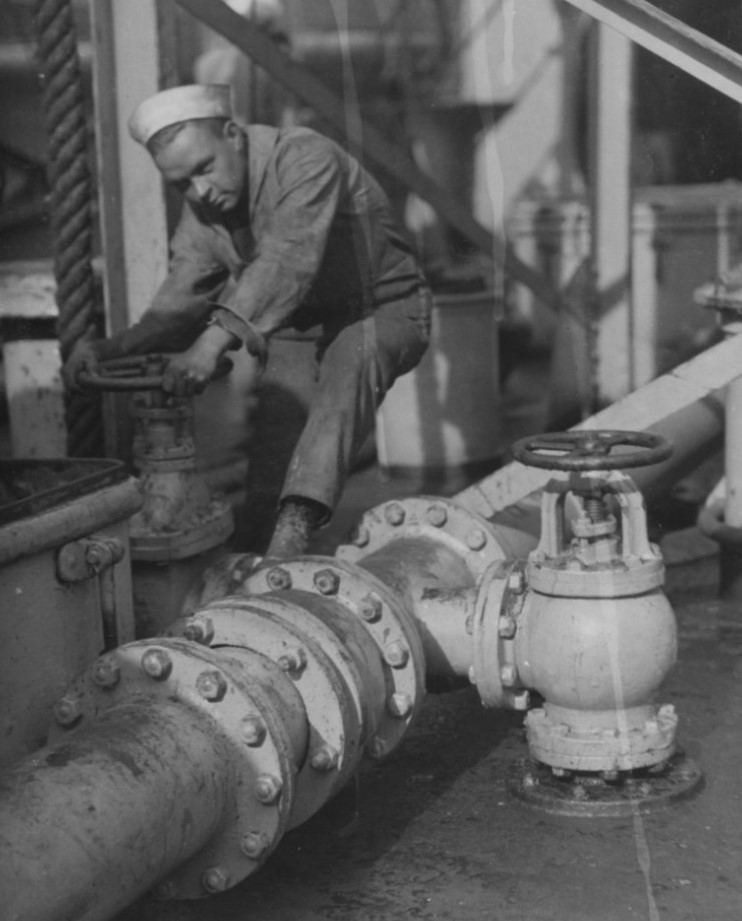
Refueling with oil on the USS New Mexico
Oil also had significantly more energy per unit mass than coal did, giving an increase in steaming endurance for a given weight of fuel of between 30 and 55%. Oil burned cleaner, reducing the clouds of smoke that revealed a ship's position to her enemies. This also meant that the fire grates didn't have to be cleaned of ash, another limit on high-speed endurance. One downside of the removal of coal was the loss of its protective effect. Coal was considered important protection from flooding, as it would remain in the bunker and take up most of the space, and an underwater explosion was expected to spend much of its energy pulverizing any coal it encountered. In practice, the inboard bulkhead of the coal bunker was pierced by scuttles to allow access to the coal, and the scuttles would either be left open by the crew or spring under the shock of a torpedo hit. Later, when navies realized they'd overestimated the flammability of oil, it became an important part of underwater protective schemes.
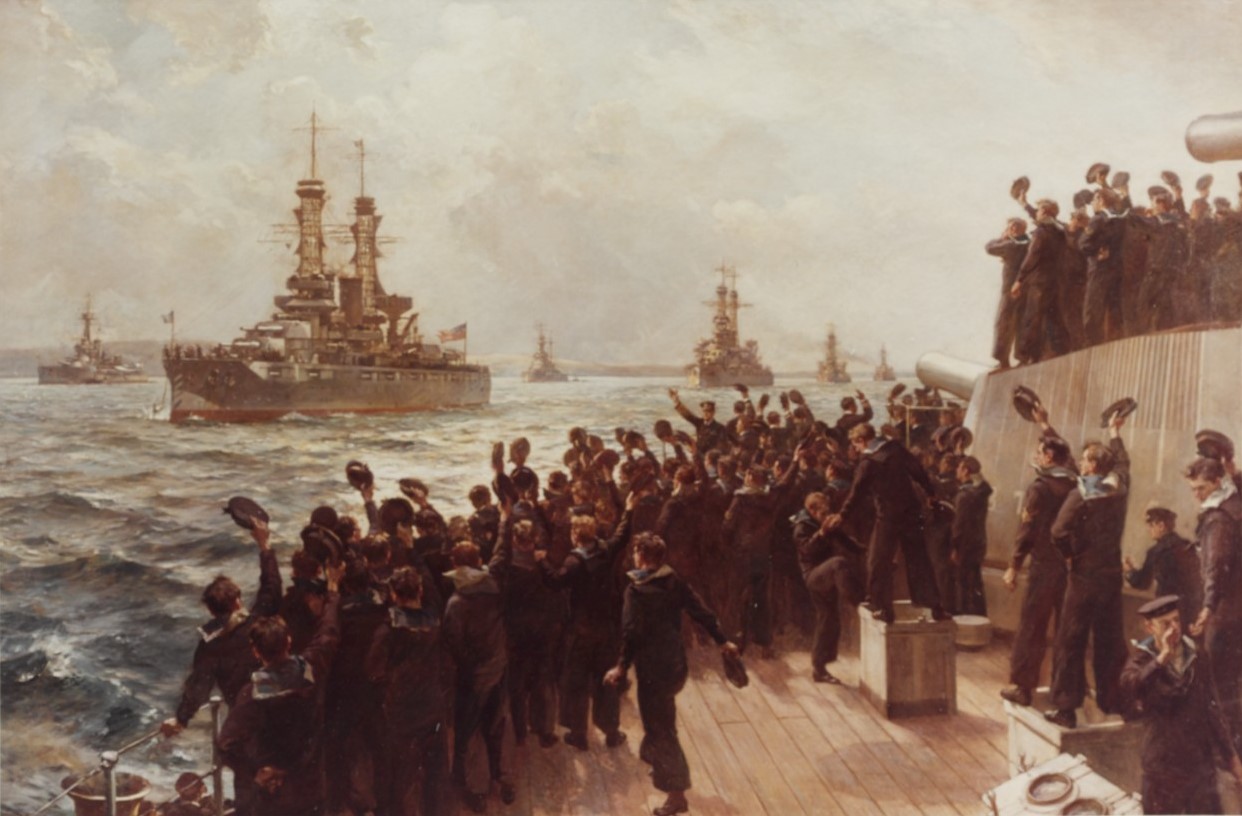
Battleship Division Nine arriving at Scapa Flow
Another interesting characteristic of oil was the way it changed naval geography. One of the reasons that the US was the first adopter of oil was that the US was also the holder of the world's largest oil reserves. Germany and Britain both had large supplies of coal, but lacked oil entirely. With the US swinging its attention to the Pacific, coal supply was becoming a problem, while oil was readily available from the Long Beach field, just a few miles from the fleet's base at San Pedro. The British, on the other hand, were seriously concerned with their oil supply, and even attempted to go back to the use of coal in the Revenge class, after introducing oil in the Queen Elizabeths.9 This limitation meant that when the US sent battleships to augment the Grand Fleet during WWI, the most modern ships were retained in home waters, and the older coal-burning ships served with the British.

Battleship Division Nine off Scotland
The combination of the turbine and oil fuel revolutionized warship propulsion, but more was to come. The rest of the battleship's life would see further innovation, most notably to solve the problem of the speed mismatch between turbines and propellers, and the steam turbine brought to its peak of power and reliability. But that's a subject for next time.
1 The really, really crude description of the steam turbine is that it's a bunch of windmills all fastened together and run by steam pushing through them. Obviously, the details are somewhat more complicated. ⇑
2 This is about the same power as two Iowas. ⇑
3 Interestingly, the first battleship with a turbine of any sort was Victoria, where it drove a dynamo (electrical generator). ⇑
4 The sketch designs for the Invincible class battlecruisers showed 3,700 tons of machinery for reciprocating engines and 3,000 tons for turbines. It's a rule of thumb that a ton of direct change in weight is going to produce about another ton of indirect change in weight from the hull and armor, so the actual savings were around 1,400 tons. ⇑
7 The Lord Nelsons could make 9,180 nm at 10 kts, while Dreadnought actually lost radius below 12.9 kts, showing how bad the low-speed consumption of turbines was. ⇑
8 The Queen Elizabeths, ordered at the same time, were changed while being designed from coal to oil. ⇑
9 The Revenges were converted while under construction to oil. ⇑

Comments
But what really happened, of course, was not that ships became smaller, but they used that extra available tonnage to become better-armed and -armored, plus faster ;)
That sentence was meant to be about the turbines themselves, not the resulting ships. (Which were smaller for the performance they had, but size is usually determined by other factors.)
I would have really liked being the mythical fly on the wall at the 1897 Naval Review, when the Turbinia started zigging and zagging around, while everybody tried to catch her.
Turbinia looks like she's asking to be shot, given that she's the size of a torpedo boat and acting vaguely like a hostile one, but presumably wouldn't have done it if that was actually likely.